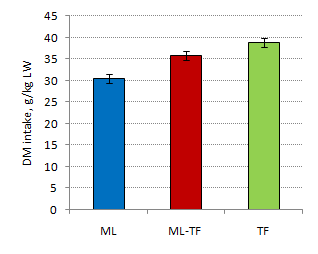 |
 |
| Figure 1. Effect of replacing mulberry leaf silage with silage of Taro foliage (leaf + stem) on DM intake | Figure 2. Effect of replacing mulberry leaf silage with silage of Taro foliage (leaf + stem) on coefficients of apparent digestibility |
|
MEKARN Conference 2010 |
Three crossbred castrated male pigs, weighing on average 24
kg were allotted at random to 3 diets within a 3*3 Latin square, to study the
effect of Taro (Colocasia esculenta) silage (leaves + stems) and mulberry
leaf silage, or a 50:50 combination of both foliages, on digestibility and N
retention of growing pigs fed a basal diet of rice bran. The rice bran was
restricted at 1% of body weight (DM basis) while the silages were fed ad libitum.
Diets with 67% of mulberry leaf silage plus 33% rice bran and 74% Taro (leaf + stem) silage with 26% rice bran (DM basis) supported relatively high rates of feed intake (30 and 39 g DM/kg LW/day). The mixed silage (50:50 as DM of each forage) was consumed at 36 g/kg LW/day. Apparent digestibility coefficients for DM, crude protein, NDF and ADF were higher for diets containing Taro silage compared with mulberry silage alone, with no difference between 50% Mulberry-50% Taro silage and 100% Taro silage. N retention when corrected for N intake did not differ among diets.
It is concluded that the
protein in Taro foliage (leaves + stems) is more digestible than the protein in
mulberry leaves but that the biological value of the protein is similar for both
foliages.
 |
 |
| Figure 1. Effect of replacing mulberry leaf silage with silage of Taro foliage (leaf + stem) on DM intake | Figure 2. Effect of replacing mulberry leaf silage with silage of Taro foliage (leaf + stem) on coefficients of apparent digestibility |